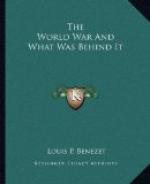The descendants of these people are to be found today throughout the Balkan peninsula, though mainly in the large cities. They are so numerous in Constantinople that four newspapers are published there in the Spanish language, but printed in Hebrew characters. The city of Salonika, a prosperous seaport of 140,000 people, which used to belong to Turkey but now is part of Greece, has over 50,000 of these Jews. They readily learn other tongues, and many of them can talk in four or five languages besides their native Spanish, which they still use in the family circle.
Constantinople (called Stamboul by the Turks) is a polyglot city, that is, a place of many languages. Greeks, Turks, Armenians, Jews, Italians are all found mingled together.
[Illustration: A Scene in Salonicka]
The main source of trouble in the Balkan peninsula is that the races and nationalities are so jumbled together that it is almost impossible to say which land should belong to which nation. Take the case of Macedonia (the district just northwest of the Aegean Sea). It is inhabited largely by Bulgarians, and yet there are so many Greeks and Serbs mixed in with the former that at the close of the last Balkan war in 1913, Greece and Serbia both claimed it as belonging to them because of the “prevailing nationality of its inhabitants!” In other words, the Serbians claimed that the inhabitants of Macedonia were largely Serbs, the Greeks were positive that its people were largely Greeks, while Bulgaria is very resentful today because the land was not given to her, on the ground that almost all its inhabitants are Bulgarians!
Religious and racial hatreds have had a great deal to do with making the Balkan peninsula a hotbed of political trouble. Right in the center of Bulgaria, for example, speaking the same language, dressing exactly alike, doing business with each other on an equal footing, are to be found the native Bulgarian and the descendant of the Turkish conquerors; yet one goes to the Greek Orthodox Church to worship and the other to the Mohammedan Mosque. With memories of hundreds of years of wrong and oppression behind them, Bulgarians and Turks hate and despise each other with a fierce intensity. Let us now leave the Balkan states, with their seething pot of racial and religious hatred, and turn to other causes of European wars.
Questions for Review
1. What became of the Greeks when the Turks
captured Constantinople?
2. Why could one county of Serbia resist
the Turks?
3. How long after the fall of Constantinople
were the Turks
threatening Vienna?
4. Explain how Constantinople has people
of so many different
nationalities.
5. Why have the Turk and Bulgarian never
been friendly?
CHAPTER VII
The Rise of Modern Nations




